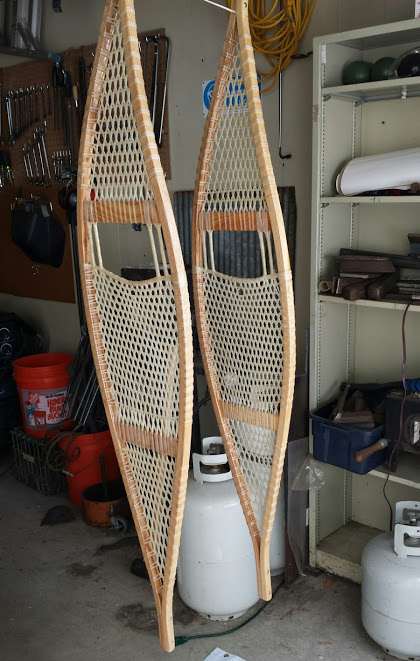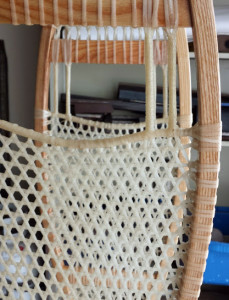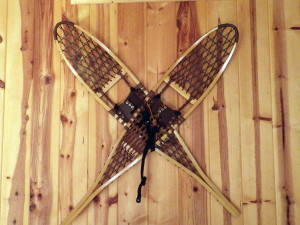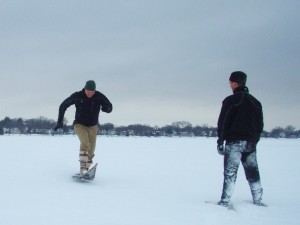Hello, my name is Darren, and I’m a laceaholic. I guess the first step is to admit you have a problem.
 The problem I have is that I don’t have enough frames ready for lacing. Lace in the summer when varnish dries without heating up the shop, and steam bend frames when it’s cold. Problem is that I didn’t have my bending jigs done for the winter season so I am using pre-bent frames I get from a guy who makes snowshoes. Goal for October: frame jigs completed, then I can make a dozen frames and be set for the summer.
The problem I have is that I don’t have enough frames ready for lacing. Lace in the summer when varnish dries without heating up the shop, and steam bend frames when it’s cold. Problem is that I didn’t have my bending jigs done for the winter season so I am using pre-bent frames I get from a guy who makes snowshoes. Goal for October: frame jigs completed, then I can make a dozen frames and be set for the summer.
This pair is a new pattern that took some experimentation to get the lacing to come out symmetrical. There is 60 feet of lacing in the tips and tails, 95 feet in the center footbed. 8 feet wraps the toe cords to add durability. It takes about an hour or so to do a tip or tail, a few hours (or one full-length movie) to do the footbed. So total time invested in a pair is about a day plus varnishing time, maybe an hour or so. Total lacing is about 500 feet per pair. I have 2400 feet left on the spool.
I now have four or five pair of traditional snowshoes I have built, along with a dozen other pairs I have build for other folks. I taught building and that was fun, but now it’s just a hobby. Wife 1.4.3a knits, I lace.
I use Pettit Amber Spar Varnish…that’s the good stuff. It’s $40.00 a quart, but consider the garbage in a can (Minwax polyurethane at Home Despot) costs $15.00 a quart, the extra cost for a pair of shoes might be as high as $3.00. The Minwax brand was good stuff maybe a few decades ago, but they were bought (of course) by a larger company, who started squeezing out the expensive ingredients so they could make an extra 12 cents a quart.
ingredients so they could make an extra 12 cents a quart.
Pettit (and Epiphanes and all the other good brands) glide on the wood and lacing smoothly, and they don’t foam up and leave bubbles that later need to be sanded or steel-wooled off. They are easier to use, cover better, and all in all, I can’t see why anyone would use a cheaper varnish unless they didn’t know about the good stuff.
Now you know about the good stuff. I am exculpated.
I am now prepping another set of frames: sanding, scraping, making a few modifications to the cross members (aesthetic but also functional, adding more toe clearance). I continue to experiment with lacing patterns and materials, and I have scale drawings of the frame jig I’m going to make. I’m making some modifications so the toe will rise a little differently, a lot more traditional-looking and probably a little lighter too. Certainly lighter than these beasts, Alaskan 12x60s, the first pair of snowshoes I ever built, 26 years ago. Little did the folks at Mosquito Hill Nature Center know what they set in motion when I signed up for a class in the winter of 1988.

Now to find some long ash logs from which I can split out staves. Sawn boards don’t work because they are usually kiln-dried and brittle. You can work around that by soaking the boards for a while, but the big problem is grain run-out. If you try to bend a piece of wood where the grain runs out, it’ll split and you’ll have a nice piece of firewood. The same is true for longbows, by the way. So you need to follow the grain, listening to the wood with a certain feng shui and taking it slow with the drawknives.
Anyway, first coat is tacky and by tomorrow will be ready for another coat. They’ll turn more amber-colored as I add coats, probably a total of three. Leather bindings are already ready to go on. Then we test them…

This was a few years and a few pairs ago. I floated. Modern shoes sank.
Respectfully submitted,
Canoelover

You can not quit! You found another passion.